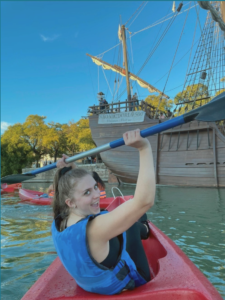This week, Verto Spain student Kira Goret shares her perspective on cultural differences and the amazing things she’s seen in Seville.
*** This is an example of a student’s experience from Fall 2021. Specific programming and activities are subject to change semester by semester.

Cultural differences between every place in the world are evident, but those differences have the potential to push groups of people together and force them to be more globally aware. Studying abroad is a great leap towards understanding this concept.
Throughout my experience here, I have been able to see and accept the various cultural differences between Spaniards and my hometown, both positive and negative (mostly positive).

First and foremost, architecture is a force to be reckoned with—it surrounds you everywhere you turn and it is breathtaking. Whereas, in my town, the architecture is more modern and in turn either crumbling or without classic character. Personally, I am more drawn to Classical, Baroque, Greek & Roman, and Moorish architecture, which you can really only find in this part of the world, at least to the extent there is here. In the states, we definitely have little tastes for each of these types of architecture but not on the level, there is here.

Ultimately, locations like this one comprise a lot of the architectural character of Spain and you just don’t find that in many places in the states. Spanish culture, and European in general, seem to value the beauty of the art created by previous generations, and in that aspect, I adore the European mindset.
The collage of photos above are photos I took both outside and within the cathedral, all of which I believe captures the beauty of the complex, but still cannot do justice to the presence felt when inside.
The next cultural difference that I’ve seen, similar to the architecture, is the art. Whether it’s in the streets or in a museum, the art speaks to me more than any I have ever seen. Again, I am drawn to Classical and Baroque art, yet anything with an interesting form, story, and technique catches my eye. Not only me though!
Here we can see Grace Cohen, a fellow Verto student, admiring a piece of art in the Museo de las Bellas Artes, only a five-minute walk from our residencia here in Sevilla.
Through the art we’ve seen in Spain, each of us art-enthusiasts has been able to glimpse into the past and how crucial it was for Spaniards and other Europeans to express themselves and their culture using this medium.

These black and white photos are of replicas of some of the most famous sculptures in the world—plaster molds taken directly from the originals. Each of these rests in the Universidad de Sevilla, where our Art History professor guided us through a hall of sculptures like these. Just another example of how influential art from centuries ago still is to students all around the world. Although not shown, the university’s School of Fine Arts has another collection in one of their studio classrooms that, I think, is just as impressive as this one, therefore furthering the fact that students here in Sevilla have quite a lot of classical inspiration.

Though I’ve never been inside this restaurant, walking past it one Sunday morning this mural caught my eye. I was immediately entranced by its simple beauty and ability to capture a Spanish woman and her gentle yet stunning features.
This picture represents a modern yet classical take on street art, something that is ever-present in Spain.
Despite Sevilla’s cultural differences to my town in the states, as well as the towns of others in my cohort, Sevilla does have some similarities in the activities that one can participate in. A very exciting one that I and many other students got to participate in was kayaking!
A group of us were able to kayak for about an hour and a half on the canal, a ten-minute walk from our house. Here you can see Kendall Thomas and Lola Gutierrez enjoying their time on the water!
Ultimately, both the differences and similarities of our cultures are what connect us to one another, even if it’s from 6,000 miles away. So always be aware of the influence your experiences and actions have on other cultures and accept the influence they have on you.


